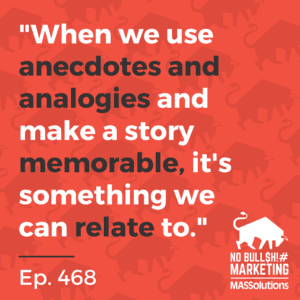Podcast
468: The Importance of Storytelling in Business
EPISODE SUMMARY
Storytelling, a popular brand marketing tool, is nothing new to people who have been communicating this way all throughout history. Still, consumers are not the only ones your company should be focusing on. By utilizing business to employee storytelling and referral source storytelling, leaders will see growth in the recruitment, retention, and results of their business.
EPISODE TRANSCRIPT
It’s the No Bullshit Marketing Show. I’m Dave Mastovich, CEO and founder of MASSolutions, the world’s only no bullshit marketing consultancy.
Storytelling. It has now reached the pantheon of buzzwords. I remember back in 2015, when I started using the term storytelling to explain how significant it was for businesses and leaders to leverage storytelling. We were retained in this controversial PR situation to help a community organization to make big time news that they had hired us. One person was interviewed and said, “Storytelling? Why do they got to tell stories? Why can’t they just tell the truth?” in reference to MASSolutions being engaged to help these organizations and the community. And so it went from that being a perception that storytelling was this thing like, “I’m going to tell a bedtime story,” to, now, storytelling being a buzzword. It’s up there with the past history of buzzwords where you had onboarding and one now is stack. You have your technical stack, you have your cell stack. So stack is a buzzword. So storytelling has reached that buzzword status. But there’s still a misperception of what it really means. There’s still a segment of people that I’ve run into a lot – chief executives, and C-suite people, and owners and founders, who are maybe in the older part of Gen X or are already part of Boomer – and they still see this term of storytelling as not this power for them that’s needed. And then there’s a younger audience that bought into the buzzword status of storytelling, and kind of still don’t really understand the meaning.
So today, what I want to talk to you about is why storytelling in business matters so much, and why storytelling in business has to go beyond brand storytelling. So first, for those who are in that group that aren’t quite convinced that storytelling is this measurable, powerful thing, and maybe they see it as a soft thing, as something that used to be talked about as maybe hackneyed or even BS that it was just telling a story. To that person, I say, storytelling is the one tool that we have used across generations, for hundreds of years, across cultures. It’s the one tool that has been used to educate, communicate, and motivate since the history of our life. It’s because when we use anecdotes and analogies and make a story memorable, it’s something we can relate to.

It’s something we pass on to others, even pass on generation to generation. There’s a science to storytelling as well. So for those who still haven’t bought in, that storytelling has to be a part of leadership and has to be a part of business, I say okay, I understand. It takes a while to have some data behind it and to understand that it’s not soft. So the science of storytelling talks about how we, the cognitive psychologists say, that we begin to formulate stories. When we meet someone, and when we engage and interact, we begin to put that person at the forefront of the story. That person becomes the focal point, we want to understand their goal and who they’re trying to reach and influence. Our mind starts to do this anyway. It’s the science. We then want to look at what their struggle has been, what barriers have they overcome. That’s why you see the plotlines to shows on Netflix and movies, is we want to understand the struggle, the barriers that that person had to overcome. We also want to relate to who helped and how. That’s why you see so many shows, in the pilot, they pull in the four or five other characters and tell us how that person helped the hero or heroine fight through the barriers and struggles that they overcome. We want to know what lessons were learned. This is what the science tells us we begin to do on a regular basis. Our mind moves so fast.
So for those who haven’t been convinced yet that storytelling is beyond the soft bedtime stories of generations ago, and the misperceptions around storytelling, know that there’s a science to it. And that leaders leverage it and have throughout their careers. Leaders have been to the point where they are at, wherever they are in their career, because they’ve been able to communicate. And when you can communicate, it comes from the power of storytelling. But let’s flip to the other side, to all these people that have made storytelling a buzzword. All these people that have overused storytelling, and aren’t using the science of storytelling, are hurting the cause of No BS Marketers and No BS Storytellers. That’s because many people use storytelling mainly when they’re doing brand storytelling, or even a tactical piece of storytelling, digital storytelling, or social media storytelling. And they aren’t necessarily leveraging the science and the power of storytelling, and they aren’t understanding beyond the one target market, the general public, broader target market, or even at a sliced and diced little bit with a particular social media outlet or channel. Those people are focusing on brand storytelling, or tactical storytelling, which are both important. But for businesses and leaders, storytelling goes far beyond brand storytelling, and can’t be just tactical implementation of a story by taking a picture and posting something, or having an event.
The storytelling beyond that brand storytelling falls into a number of key categories. One is what we call B2E, business to employee storytelling. Most companies do either B2B, business to business, or B2C, business to consumer. They’re used to treating those target markets in a certain way, and having a plan and a campaign and using the science of storytelling, or maybe using target market segmentation, marketing insights. But those same leaders and businesses often fail to reach, influence, connect, and engage through that super important target audience of employees and B2E business to employee marketing. Treat prospective and current employees as the customers that they are. B2E marketing then leverages B2E storytelling, and tells your story in a way that helps with the three R’s of business to employee marketing: recruiting, retention, and results. Now, recruiting and retention are somewhat obvious.

You know that we’re in this supposed talent war and a great resignation. So telling your story in a way that talks about your culture and talks about what’s in it for them beyond the actual main tasks that they’ll do, that can help with recruiting, and can also help with retention. But where B2E storytelling makes a big result on is on results, because 82% of employees, regardless of company or industry, believe that their productivity suffers because of poor or limited communication, up, down and across the organization. 82% believe their productivity could go up. That’s the results. Their results could be improved if communication were better. Now, when I speak across the country, to C-suite organizations, leaders, middle managers, I hear again and again, “Well, we tell them the why and we talk to them about the processes.” But they’re talking to them in the way that they want to communicate, and they’re not treating them the way they treat their customers. They understand that customers need to be reached through different channels. A billboard might work in conjunction with a broadcast and television commercial on cable, but it also might use social media outlets. And you might use a video that you sent to a prospect to tell them, you might communicate in six, seven channels to your target audience. You know you have to make that message creative when it’s the consumer. But we’re telling employees what to do in the manner that we want to tell them. So B2E helps with results, when we look at that employee segment, and we slice and dice it just like we do our customer segments. And we craft creative, memorable messages and stories around anecdotes and analogies. Anecdotes and analogies. So that’s the first group that goes beyond brand storytelling and beyond tactical storytelling. To those of you out there who believe in storytelling, you’re convinced storytelling is powerful, and that we need to do it, I want you to go beyond brand storytelling and tactical storytelling on social media to your customers and prospects. I want you to think first about B2E, business to employee storytelling. But another area that’s neglected, and I often say it’s the Captain Obvious, are these two target markets that are neglected. One is employees and the other is referral sources, centers of influence, people who can introduce you to potential clients, people who can refer people to you, who can give you reviews and testimonials. They’re not necessarily your customers, they’re referral sources. And I find that companies don’t systematically approach the referral sources in their centers of influence, in the same way that they systematically approach their current and prospective customers. So referral source marketing also requires the planning that you do for customers, and we want you to do for employees. And then it includes referral source storytelling, which is different from the customer storytelling, it’s different from your employee storytelling. Your referral source storytelling is explained to them, how they can help themselves and their network by talking about you, and what’s in it for all of those parties. That’s referral source storytelling.
And then there’s leadership or executive storytelling. I find that leaders and executives leave storytelling opportunities on the table. They don’t leverage the many chances they have to talk to their target audiences, which could be board members, could be investors, could be their peers, it could be other employees. That leadership or executive storytelling needs to be done in a creative but systematic way using the science to leverage the power of storytelling.
So those are the ways that I wanted to talk about, first, why storytelling is so important to business and to leaders, and then why storytelling has to go beyond brand storytelling or tactical storytelling, and to touch on business to employee storytelling, referral source storytelling or Centers of Influence storytelling, and leadership or executive storytelling. Thanks for listening to another episode of the No Bullshit Marketing Show recorded here in MASSolutions studio in bold, beautiful, downtown Pittsburgh, Pennsylvania. Remember, ask yourself, “What’s the big idea?” and build your story around the answer. It’s all about bold solutions, no BS.
Important Links
Listen Here
 |
 |
 |
 |
 |













